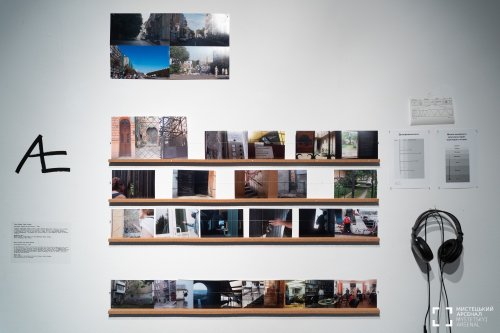«(RE)CONTEXTS. FRAGMENTS» EXHIBITION
On March 4, the exhibition (Re) contexts. Fragments opened in the space of the Laboratory of Contemporary Art — Mala Gallery. Within only a week a quarantine suspended work of the exhibition. During the quarantine, Mala Gallery accepted the challenge of switching into the online mode — participants of the exhibition wrote about their works on the Facebook page of the Mala Gallery.
On July 3, the Laboratory of Contemporary Art — Mala Gallery — opens the exhibition (Re) contexts. Fragments for the second time. The exhibition will run until August 30.
Project (Re) contexts. Fragments continues the (Re) contexts. Stories programme, initiated by the Laboratory in the summer of 2019. The programme invited participants to work on ways and approaches to the storytelling of personal and collective history, using a variety of artistic mediums and instruments. As part of the programme, two exhibitions were planned to showcase the completed projects of programme participants.
The first exhibition was titled after the pogramme — (Re) contexts. Stories — gathering in one space the works based on different personal stories and local contexts. It took place at Mala Gallery in October of 2019. The second exhibition is called (Re) contexts. Fragments and focuses on the works that somehow capture the fragments of the past, everyday life, that are gradually eroding and disappearing from our memory. In this way, the authors emphasize the temporal fluidity and fragility of things that at first glance seem unchanged and firmly rooted in the surrounding landscape.
The subject of disappearing objects in public space is referred by the artist Kseniia Bilyk. In her artistic practice, she combines an architectural experience with an interest in neglected bulding structures. Her project Ruins is a visual study of the urban landscape, in which she distinguishes its most characterizing symbolic patterns, corresponding to the three content blocks — home, work, the church. Using the tapestry as a medium, the artist creates a situation in which some materials are contrasted with other, more reliable materials (stone, wood, metal). In this way, the artist emphasizes the fragility of architectural objects in the urban space.
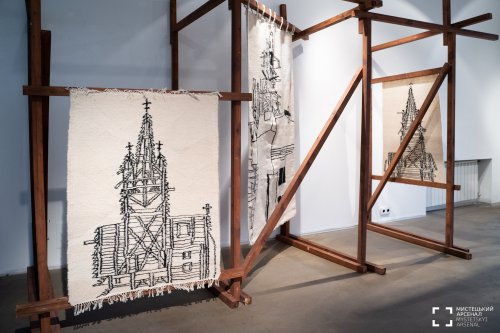 Ruins, 2018, Kseniia Bilyk. Photo: Oleksandr Popenko © Mystetskyi Arsenal
Ruins, 2018, Kseniia Bilyk. Photo: Oleksandr Popenko © Mystetskyi Arsenal
Daniil Shumikhin builds his work on the ironic juxtaposition of the past and the present. As a basis, the artist uses the image of Kherson in the 1980s, showing it as a true “Dream City”. The banner "We want to live like in Kherson", which according to the author people of other USSR cities used to bring on the streets, reflects this idea. In his project, the artist raises the question: "Does Kherson remain as attractive for living as before?" Using the aesthetics of Soviet postcards, Shumikhin marks them with modern places of Kherson, pointing to their condition and loss of attractiveness.
 We Want to Live Like in Kherson, 2020, Daniil Shumahin.
We Want to Live Like in Kherson, 2020, Daniil Shumahin.
Photo: Oleksandr Popenko © Mystetskyi Arsenal
The problem of comprehending the history of everyday life is addressed in work by Starko / Martynchuk group. The artists analyze it using the example of diminishing public catering places and their disappearance from urban space. In its aesthetics, the work is similar to a museified archive, with the main objects — authentic places of public dining (i.e. café, eateries, or canteens) and drinking. As a result of gentrification, well-known burger places (cheap places to “drink out”), mini-bar, or cafe undergo a systematic "upgrading", which eventually leads to their disappearance. The art group creates a space that allows viewers to look at this phenomenon comprehensively, without nostalgia, and to think of what these places became and what are their potential perspectives.
|
|
|
Unknown pleasures, 2018, Starko / Martynchuk group.
Photo: Oleksandr Popenko © Mystetskyi Arsenal
Olena Zagrebina refers to the observation and fixation of reality in her work. Zagrebina’s photography series Careful, landslipe! tells about the shattering of the shore that happened in the village of Lebedivka, Odessa region. In her photographs, the artist documents how space, which has acquired the status of dangerous, continues to be used by locals and how it becomes a part of their everyday leisure practices. In the project, Zagrebina raises the question of where is the boundary between danger and one’s own responsibility.
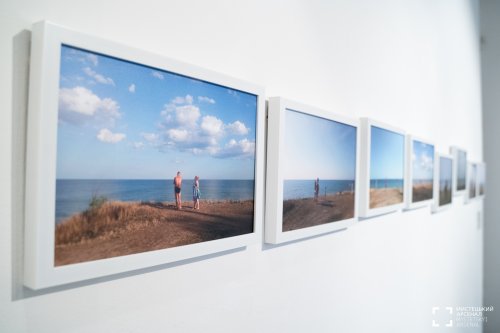 Careful, landslip!, 2018-2019, Olena Zagrebina.
Careful, landslip!, 2018-2019, Olena Zagrebina.
Photo: Oleksandr Popenko © Mystetskyi Arsenal
Julia Elias addresses the issues of the policy of memory and national identity in her work. The artist creates an animated image in which she reappropiates the footage from the tape Enthusiasm: The Symphony of Donbass (1931) by Dziga Vertov. Her work is a reaction to the use of the poster to the Vertov’s movie by Stedelijk Museum Amsterdam to advertise an exhibition on the history of Russian cinema. Thus, Elias emphasizes the lack of consideration of the identity of artworks and their authors by museum institutions.
 DZIGA, 2019, Julia Elias. Photo: Oleksandr Popenko © Mystetskyi Arsenal
DZIGA, 2019, Julia Elias. Photo: Oleksandr Popenko © Mystetskyi Arsenal
Academia, the work of a painter Alla Sorochan, illuminates the ambiguity of the history of the place through the personal experience. The installation combines video and audio interviews of various people affiliated with the Academy (National Academy of Fine Arts and Architecture, Kyiv), and the attributes that are characteristic to the Academy, such as podiums for live models (for figure drawing), the fabric, or gypsum statue heads. The artist's archive contains stories from different people, such as electrician and the faculty, who share important, fun, and horrifying episodes of their lives that are related to the Academy. Blending together gif-animations of interviews with the interior of an art studio, Sorochan lays one on another two realities that seem to coexist at the Academy, thus pointing to the ambiguity of the situation within the academic system.
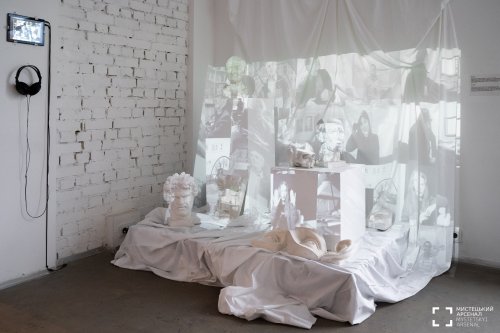 Academia, 2017, Alla Sorochan.
Academia, 2017, Alla Sorochan.
Photo: Oleksandr Popenko © Mystetskyi Arsenal
Another method of working with the reality was used in the project of the artistic and curatorial collaboration of Bogdan Moroz and Yurii Polishchuk. The work bases on a video record of the artist Bohdan Moroz who is repeating the actions of cafe and store employees, residents of Venice during the flood. At that time, Moroz was visiting the city as a performer of the Ukrainian pavilion at the Venice Biennale. When posted online, the video went viral and the exclusive rights to it were acquired by the ViralHog company, still paying the artist’s interest from sales. In this way, the work reveals the artist—market relationship and the new criteria of success.
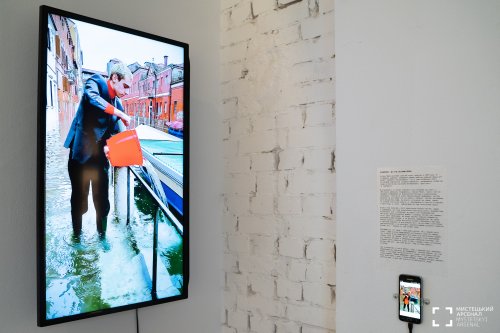
ViralHog, 2019, Bohdan Moroz / Yurii Polischuk artistic and curatorial collaboration.
Photo: Oleksandr Popenko © Mystetskyi Arsenal
Pavel Suslyakov and Tereza Yakovyna demonstrate their own method of exploring and documenting the urban landscape. The Avanturyzm project offers a methodology for studying a place through atypical, closed spaces at first glance, as well as exploring the place through the experiences of local residents. At the exhibition, the project comprises a dialogue between the authors, who are constantly changing the exposition by adding new objects, own reflections, and observations in the form of text.
|
|
The Avanturyzm. Conversation About Authenticity, 2020, Pavel Suslyakov / Tereza Yakovyna.
Photo: Oleksandr Popenko © Mystetskyi Arsenal
Exhibition participants: Kseniia Bilyk, Julia Elias, Olena Zagrebina, Alla Sorochan, Daniil Shumikhin, Starko / Martynchuk group, Bogdan Moroz / Yurii Polishchuk artistic and curatorial collaboration, Tereza Yakovyna / Pavel Suslyakov.
Consultants: Oleksandr Liapin, Ksenia Malykh, Oleksandr Soloviov, Solomia Savchuk.
Photographs from the exhibition opening on 4th of March.



